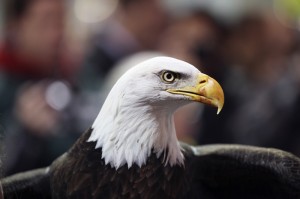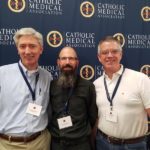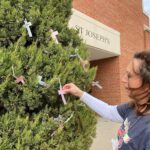By Father Bud Grant
Driving down the gravel road near my house recently, I was joined by a great bald eagle, cruising beside me as if enjoying the companionship, so close I looked into her eye.
Such wrenching moments of intimacy that we sometimes share with wild animals stir our connectedness to the rest of creation. That same night, in the prayers for Thursday after Ash Wednesday, I read: “nature itself is a lesson for all the faithful in the worship of God. The heavens, the sea and all that is in them bear witness to the goodness and omnipotence of their Creator, and the marvelous beauty of the elements as they obey him demands from the intelligent creation a fitting expression of its gratitude” (St. Leo the Great, sermon 6 for Lent).

Decades ago it was very rare to see a bald eagle, so close were they to extermination. Now, especially along the locks and dams in winter, they are abundant (I would never say “common,” in reference to this evocative icon). Having almost lost the bald eagle, we chose to save it.
After World War II, in a sincere effort to control insect pests, we applied DDT broadly throughout the landscape. It worked far more thoroughly than we anticipated, finding its way into water systems, invertebrates, fish, the eagle and, finally, thinning the eagle’s egg causing it to shatter under the nesting parents (males and females share in this task). Because it is our national symbol and thanks to Rachel Carson’s “Silent Spring” (1962) which revealed the connection between DDT and illness, we responded.
The Environmental Protection Agency was founded in 1970 to protect the environment and human health. We banned DDT in the U.S. in 1972 (though it was sold abroad until 2001). We created the Endangered Species list in 1973 to preserve habitat. It worked: the bald eagle was removed from the endangered species list in 2007. We also see hope for other native species, which Chad Graeve, an ecologist friend of mine, calls “charismatic megafauna:” grizzly bear are “threatened” (a step down from “endangered”), the wolf is being considered for de-listing in some regions and the plains bison is off the list. Of course, 16,938 species are still threatened (International Union for the Conservation of Nature “red list”).
Still, we’re learning our lessons. First, the eagle was already in decline before the debacle of DDT because of hunting and habitat loss. Lesson 1: mismanagement is a kind of management, even if done out of ignorance or inaction. The damage was not to the eagle directly, but far down the food chain. Lesson 2: nature is complicated; we may never understand how any one change impacts everything else. We never intended to decimate the eagle population. In fact, we thought that we were doing a great public good. Lesson 3: we will make mistakes. Intentions alone don’t make for good actions. The restoration of the eagle does not mean that we can declare victory since its habitat is under chronic threat. Lesson 4: “wild” is gone. Management is the only (eco)logical game plan.
I once suggested to my ecologist friend that he is not really trying to “restore” the ecosystem to some mythically pristine condition, but to save it the way a physician heals a patient who, nonetheless, won’t enjoy the same lifestyle she had prior to the health crisis. “I am not,” he clarified, “trying to save nature. I’m trying to save our relationship with nature.” Relationships, we all know, are not static and cannot be captured in one frozen moment of perfection. Rather, they take constant, deliberate and loving effort to maintain — manage — steward.
The bald eagle is not wild, but with our (always fallible) management, she will soar the heavens “bearing witness to the goodness and omnipotence of their Creator, demanding us to be grateful to the One who created us all” in relationship.
(Father Bud Grant is a professor of theology at St. Ambrose University in Davenport.)











